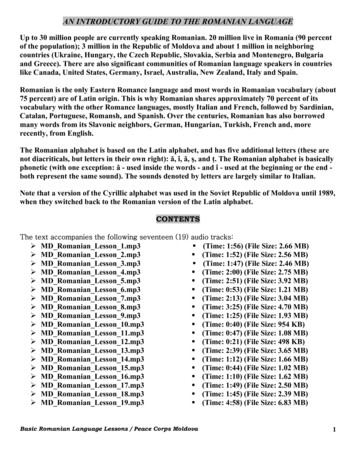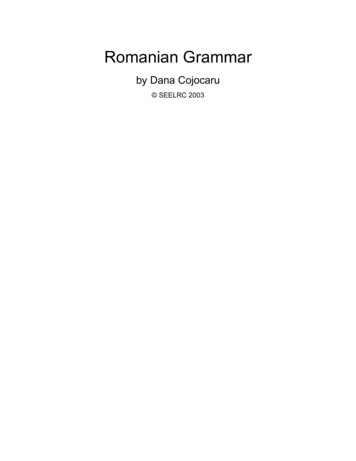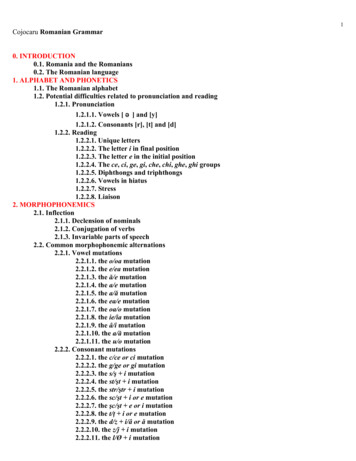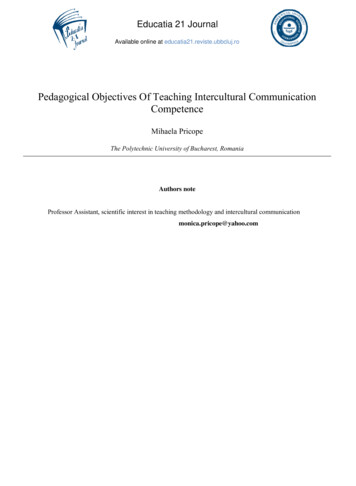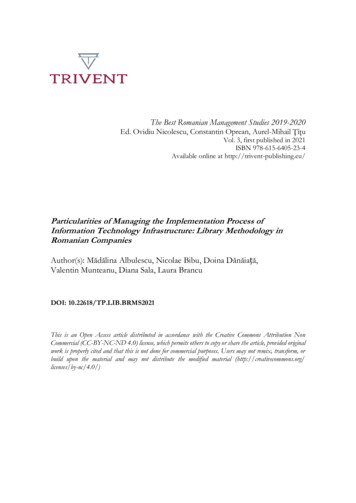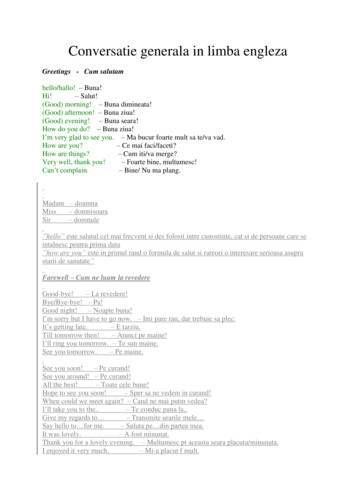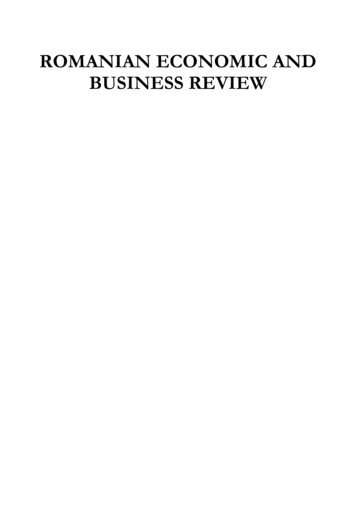
Transcription
ROMANIAN ECONOMIC ANDBUSINESS REVIEW
2Romanian Economic and Business Review – Vol. 15, number 2EDITORBogdan GlăvanRomanian American Universityinstitutions and public policy, within both a nationaland international context. REBE encourages crossdisciplinary research work of Romanian and foreignscholars.ASSOCIATE EDITORSLucian BoteaMarian-Florin BusuiocFlavia AnghelLuminiţa TuleaşcăIuliu IvănescuRomanian American UniversityIndexed and/or Abstracted in:EBSCO; EconLit; ProQuest; DOAJ; IndexCopernicus; RePecEDITORIAL BOARDMoisă Altăr, Romanian American UniversityFlorin Bonciu, Romanian American UniversityMohamed Latib, DeSales UniversityGalen Godbey, DeSales UniversityAnthony Evans, European Business SchoolAndras Inotai, Institute of World Economy, HungaryAcademy of ScienceGheorghe Lepădatu, Dimitrie Cantemir UniversityMihai Aristotel Ungureanu, Romanian AmericanUniversityIon Stancu, Academy of Economic StudiesConstantin Floricel, Romanian American UniversityGeorge Ionescu, Romanian American UniversityNikolay Gertchev, European CommissionMarcel Moldoveanu, Institute of World Economy,Romanian Academy of SciencesAlex Sharland, Barry UniversityIon Pohoaţă, Alexandru Ioan Cuza UniversityTheodor Purcărea, Romanian American UniversityNicolae Idu, European Institute of RomaniaCosmin Marinescu, Academy of Economic StudiesOvidiu Folcuţ, Romanian American UniversityJosef Sima, University of PragueLaurenţiu Anghel, Academy of Economic StudiesIlie Vasile, Academy of Economic StudiesKlodiana Gorica, University of TiranaPacha Malyadri, Osmania UniversityAndreea Budacia, Romanian American UniversityBogdan Wlodarczyk, University of Warmia andMazuryStatement of PurposeThe Romanian Economic and Business Review (ISSN1842-2497) intends to provide a forum for academicanalysis of the economic phenomena andinstitutions affecting the world economy in general,and Romania, in particular. REBE examines a widevariety of phenomena related to economic growthand business development and attempts to publishhigh quality research focusing on the role ofAuthor InformationThe ROMANIAN ECONOMIC ANDBUSINESS REVIEW (REBE) is a refereed journalpublished four times annually by the RomanianAmerican University. The editors invite submissionsof articles that deal with important issues ineconomy and business. Papers that focus on specificphenomena and events affecting Romanianeconomy are particularly encouraged. BecauseREBE seeks a broad audience, papers should becomprehensible beyond narrow disciplinary bounds.Manuscripts should not exceed 8,000words and must conform to the REBE’s stylerequirements, which are guided by The ChicagoManual of Style (14th edition). All submissions mustinclude a cover sheet explaining the scope of thearticle, and including the authors’ names andaffiliations, telephone and e-mail address. The textshould be single-spaced. References are cited withparentheses using the author/date/page style.Example: (Marcus, 2005, p. 74). Authors should usefootnotes, not endnotes to add only shortcomments. Bibliography should include onlyreferences cited in the text, in the alphabetical orderof authors. An abstract of no more than 200 wordsshould be included.Submission of a paper implies that thepaper will not be submitted for publication toanother journal unless rejected by the REBE editoror withdrawn by the author, and that it is an originalwork. All submissions should be sent to the journalEditor:Dr. Bogdan GlăvanRomanian-American UniversityBulevardul Expoziţiei nr. 1BBucureştiE-mail: bogdan.n.glavan@gmail.comSubscription rates:Institutions - 100/yearIndividuals - 30/year
ROMANIAN ECONOMIC ANDBUSINESS REVIEWSUMMER 2021VOLUME 16NUMBER 2
4Romanian Economic and Business Review – Vol. 15, number 2ISSN 1842 – 2497
Digitalization within the Banking System as a Continuous Challenge5ROMANIANECONOMIC ANDBUSINESS REVIEWCONTENTSDUMITRU MIHAI NEDELESCUILINCA BANIŢĂDIGITALIZATION WITHIN THEBANKING SYSTEM AS ACONTINUOUS CHALLENGE7HYPOCRISY MANAGEMENT:HOW TO RESOLVE SOME BASICBUSINESS ETHICS PROBLEMS?20THE HISTORY OF ECONOMICSAND THE CONSTRUCTALTHEORY40KOBAYASHI TAKAOMICURRENT PROGRESS OF GLOBALNETWORK STRATEGY THROUGHINDUSTRY-ACADEMIACOLLABORATION IN GIGAKUTECHNOPARK NETWORK OFNAGAOKA UNIVERSITY OFTECHNOLOGY AND OVERSEABASES57HIROAKI KANEKOCRISTIAN VLADTORU TAKAHASHIHIDEKI ISHIDAKEITA SUGIYAMAALINA NICULESCU,ADRIAN RĂDULESCU,MARIAN FLORIN BUSUIOCTOYOTA MOTOR CORPORATION’SLEGACY OF TRANSFORMATIONBEHIND THE GLOBAL BUSINESSGROWTH STRATEGY66CULTURAL TOURISMCONSIDERED FROM THE ANGLEOF STATISTICAL ANALYSIS OFHISTORICAL MONUMENTS ATNATIONAL LEVEL79MARIO BOGDANOVIĆRADU ISAICCRISTIAN PĂUN
6Romanian Economic and Business Review – Vol. 16, number 2GINA (LEFTER) DOBROTĂANDRADA GRIGORERUXANDRA-MARIA CHIFANTHE ANALYSIS OF THETOURISTS’ PREFERENCESREGARDING ACCOMMODATION87GINA (LEFTER) DOBROTA,CATRINEL DRIDEAGETTING EUROPEAN TOURISMBACK ON TRACK98DODU SILVIA PATRICIAZAMFIR MARIA MICHELLE IOANAILE FLORENTA LARISATHE FAST FORWARD RESHAPEOF THE HOSPITALITY INDUSTRYIN TIMES OF GLOBAL CRISIS: AHILTON HOTELS’ PERSPECTIVE106CAMELIA-MONICA GHEORGHEELENA MUZZONEW LUXURY TOURISMPOSSIBILITIES IN THE MIDDLEEAST: ANALYZING THE ISRAELIPROSPECT VISITORS’EXPECTATIONS ON TOURISM INTHE UNITED ARAB EMIRATESIN THE LIGHT OF THE RECENTPEACE AGREEMENT BETWEENTHE TWO COUNTRIES116CAMELIA-MONICA GHEORGHETEODORA ROȘUDEVELOPING AFRICA AS ALUXURY DESTINATION124TOURISM IN THE COVID-19 ERAAND THE ATTEMPT TO SAVE ITWITH THE HELP OF SOCIALMEDIA131DEVELOPMENT TRENDS OFMOUNTAIN TOURISM ANDWINTER SPORTS MARKET,WORLDWIDE,IN EUROPE AND IN ROMANIA138THE IMPORTANCE, CONTEXTAND FRAMEWORK OFCULTURAL TOURISMDEVELOPMENT AT EUROPEANLEVEL145CEZAR OCTAVIAN MIHALCESCUBEATRICE SIONANA MARIA MIHAELA IORDACHEALINA NICULESCU,MARIAN FLORIN BUSUIOCMARIAN FLORIN BUSUIOC,ALINA NICULESCU,ANDREEA ELISABETA BUDACIA
Digitalization within the Banking System as a Continuous Challenge7DIGITALIZATION WITHIN THE BANKING SYSTEMAS A CONTINUOUS CHALLENGEDumitru Mihai Nedelescu 1Ilinca Baniţă 2AbstractWhile living in the modern era, the technological innovation happens so fast that affects dailyproducing changes in human habits, trend of activities and working trends. On the other hand, it isa great challenge for the companies to be up to date and putting in place the new emerged businesssolutions. Competitiveness on the market has never been more tight resulting in bringing newproducts, constant improving customer experience, user friendly solutions, doing banking at anytime, at any place, securely, precise, now. The regulations also must be aligned to the technologicalcapabilities and customer demands in order for the banks to be able to develop and act in the benefitof clients, constantly adopting innovation.Keywords: digitalization, digital banking, online banking, userfriendly, connectivityJEL Classification: G20, G21, O32, O331. Digitalization overviewAs defined in the Gartner IT Glosar, digitalization refers to using the digitaltehnologies in oreder to change/transform a business model into acquiring new incomesources along with new ways to produce a added value. Thus with digitalization we acton a process in wich we let aside the classical methods that suppose direct humaninteraction to use inovative technologies while doing our daily routine. To put it anotherway digitalization means to use technical compatible tools in order to raise and add valueto our work. The added value consists in high definition eficency, accuaracy, consolidateddata, efectivly coordonated reporting as per individuals or company.Digitization is the first step of towards data transformation into new technicalsolutions as we use it today creating the contemporary technologies. So, we take thephisical data and we store it on a memory platform (phisical platforms, fixed or mobileplatforms, virtual platforms).Nowadays comunication reached probably the highest point so far, considering theways to data transmision, revealing and dissemination using different types of electornicdevices having a userfriendly interface that in business we call it data visualisation, ruledby connectivity.1Nedelescu Dumitru Mihai is Lecturer at the Romanian American-University, Bucharest, iţă Ilinca is student at Romanian American-University, Bucharest, e-mail:banita.va.ilinca18@student.rau.ro
8Romanian Economic and Business Review – Vol. 16, number 2Data visualisation may be translated in the way that business decisions are taken thesedays: strongly documented with detailed information and the need to act in the blink of aneye. That is why this huge amount of relevant data managed becomes irrelevant on a classicalbusiness report but strongly meaningfull if it is presented on a chart analisys and complexdiagrams because our human brain can process data much faster in such way and the businessdecision can reach its purpose in the most effective way.Connectivity is about being active on internet, using multiple integrated technologydevices and/or tools to conduct an end-to-end procees (business or pleasure).Digitalization is about fast and complete operations, with immediate results. So itmeans having acces to highly accuracy data, in real time, securely and transparentlybetween the initiator of request and the data holder in order to produce effects. This processfrom a banking point of view can be defined creating or recreating a business relationshipor transaction processing.Now, there are other factors that must be taken into consideration while addressingthis topic: Open banking refers to using API technology to third party connections and dataexchange, as for card payment, ATM cash withdrawl. This solution uses highlytransparent data about the card holder and their account (such as public data toprivate data that is subject to GDPR regulation) together with open-sourcetechnology. Digital banking is a concept that describes the moving of banking processes fromFront Office not to Back Office but to online processing solutions. This impliesboth transforming and adapting continuously from clients and bankinginstitutions. Digital banking integrates a high level of automatic technologies intocomplex solutions in order for the end user to be able to operate its own accounts,settings and preferences independently, regardless of space and time or a momentin time, upon whenever or whatever needs. This is how it started the relationshipbetween API and AI. Online banking, internet banking or web banking, can be described asintegrated systems that convey to users (banks and other financial institutions andtheir clients) the posibility to make various transactions using a dedicated websiteor a mobile platform. The first solution of this type was issued in USA in the yearof 1981. At that moment there were using the dial-up on analog exchangeconnection to service. Our nowadays solutions use STP/FTP wires, wierless ordigital exchange connectivity, depending on the device used to realize theoperation. While using an online banking solution the system works mirroringcore data and subsidiary bank data (upon the real place that generated thebusiness relationship).2. Digitization to digitalization in. The banking systemThe banking system evolved along with humans that were experiencing theexchange of different goods or coins, the need to save-up, finacing or warranting.The banking fenomena that we describe it today as loans, deposits, returns andpayments, payment instruments, debitors or creditors were mentionned on various
Digitalization within the Banking System as a Continuous Challenge9inscription from the ancient times. The human kind had all along a constant preocupationto preserve written/inscripted evidence of goods and money exchange, since forever. Thishelped us in the process of acquiring knowledg, organising and human evolution.Worldwide, the banking system developed randomly, functioning at asymmetricallevels through the past era. Nowadays it became obvious that in a decentralised system theregulations applies differently thus favorising one country before another.Following the 1929 economic crisis the next terning point was the WWII that led to theeconomic global reconstruction. After the Big War there was a massive recession this meaningthat for each state in the world would have been impossible, in a short while, to reconstruct andsustainable develop on it’s own but with highly potential to produce results if allied together.Thus have been created specific international organisations for economical and fiancialcooperation that generated some set rules,promulgated widely. The rules were aboutcoordination, monitor, supervise, funds regulation for the member states gouvermnents.From the thechnological point of view another wide open road begun in the eary ’60with the reading and rendering of information which led to inventing the ATMs(Automated Teller Machines or Cash machines). In the year of 1967 was sent the 1stelectronic bank notification to a client and 6 years later, in 1973 it was decided that SWIFTpayment codes must be used worldwide.3. Digital transformation of the banking systemThe need of banking technology development generated the prioritization of fundsallocation along with an accentuated banking institutions drive to get involved in the ITindustry. The most peculiar requrements refer to operativity, safety, simplicity, riskminimisation, banking flows streamlining management, acces data facilities, the prospectto processing and analysing data from different sources simultaneously in order to generateon spot business solutions.Digital transformationis a continuous process of development which shows withinthe cultural transformation of mentalities and old patterns applying innovative methods atevery level of not only interracting but also into interpersonal communication. This willbe found new solutions, new ways to solve the clients demands yet their enforcement areleading to changing.In this whole process knowlege has the greatest highlight because while referring tothe market we must perceive the drends in likes, dislikes and how to use this informationto identify new mens to transform the collected data into a valuable product by quantitybut mostly by quality of it. The attention should be settled towards digital customerexperience; the shortcomings shall be assumed and transformed yet the well founded partsshall be explored into driven successfully apps. Knowledge means education, erudition,self-transcendence through learning and continuous adaptation of the human kind touphold the process of sustainable development at all levels.We have started from information and digitaizating the information, from taking thephisical data and storing it on electonic devices (FLOPPY, CD, DVD, HDD) to arrive atusing WEB BASED solutions and mobile-APPS or other dedicated thechnologies to solvevarius working or recreative tasks, paywalls, podcasts, VR.The condition to make this transformation successfuly is to put in constantly the
10Romanian Economic and Business Review – Vol. 16, number 2effort into changeing and implementing those new concepts, coordonated and at every eachbusiness level by: being digitally active which should lead to optimizing and constant improvingalso reflected in the returns; asumed engaiging in the digitalization process with the competitivity that comesin as a default criteria. This means to use modern business solutions to work andenvision future trends so that the present not so good stuff can be revised; digital maturity, meaning adopting and using AI to be efficent.4. INTERNET of things FOR bankingThe figure above illustrates what connectivity and information acces is about. Allthese processes are happening in real time, accordingly to each one’s needs regardless ifwe talk about a person or corporate entity. With the nowadays technology you can makepayments, currency exchange, see documents associated to a specific transaction, bankdepozits, loans and so on with just one click for each regardless of location and/or time.The means to acheive transactions this way are publicly detailed, easy to acces and tooperate, using any electornic device with active internet connectivity, such as a tablet,PC/laptop, smartphone.Connectivity and banking information acces is a merged concept betweentechnology and regulations that are working in symbiosys, one without each-other beingcompletly useless. This technologies developed gradually in the last 15 years, but mostlyin the last 3 years. Accordingly to RAB (Romanian Association of Banks) the technologydevelopment in banking within the project Digital Platform Agenda in 2016 stipulated“The European Banking Federation, an organization in which the Romanian Associationof Banks is a member, supports the European Commission’s plans regarding theestablishing of a single digital market, an objective which can be reached by developing inthe fi nancial and banking industry some innovative and competitive services which wouldfully meet the requirements of the consumers of fi nancial and banking services.”RAB also provides the statistical data for an overview of how europeans use thebanking services nowadays, as I quote (www.arb.ro/digital-agenda-platform): the usage rate of bank products and services at global level reached 69% in 2017,compared to 51% in 2011; 94% cash transactions in Romania compared to 68% in Western EU;
Digitalization within the Banking System as a Continuous Challenge11 8% the rate of the SMEs which sell online in Romania compared to 17% in theEU; the ”grey” market 5% down via the increasing of electronic payments by at least10% per annum, for 4 years in a row; 52% of adults made electronic payments at global level in 2017 compared to42% in 2014; in 2018 in Romania 26% of internet users shopped online compared to 69% theEU average and 10% of internet users used internet banking compared to 64%the EU average.As we can see, in the statistic presented below, Romania holds the last but one placeon daily usage technologies, before 2020.Figure 2: Digital Economy 2018The 2018 DESI (The Digital Economy and Society Index) report shows that interms of connectivity Romania ranks below the average yet this being the best result on atechnology using indicator. On a decreasing level of reporting follows digital publicservices, human capital, use of internet services and integration of digital technologies.Figure 3: Romania and the UE average performance rate 2018
12Romanian Economic and Business Review – Vol. 16, number 2On the same DESI indicators for 2020, Romania is one step higher in the hierarchy:Figure 4: Digital Economy 2020Figure 5: Romania and the UE average performance rate 2020After seeing the standard indicators improving and that connectivity in Romania isabove the European average let’s see what happens in the banking field.Figure 6: Banking using the internet in Romania
Digitalization within the Banking System as a Continuous Challenge13Romania has an increasing trend in using internet to acces banking products, thoughthe graph does not show a steady rise of this indicator the overall progress is obvious andimproving.Now if we are to replicate this indicator over Europe, Romania has, by far, alot ofprogress to make in banking field, since we are on the last pace in the Figure 7.Figure 7: Banking using the internet in EuropeThe banking and its emplyess in the digital era magazine in 2018 mentions the trendsof the digital transformation in global banking anticipating also some guidance for theautochthonous market, such as: eGovernment, Interoperability, Cyber-Security, Cloud Computing, Open Data,Big Data and Social Media. IT&C within Education, Health, Culture and eInclusion. eCommerce, Research & Development and IT&C Innovation. Broadband and Digital Services Infrastructure.Regarding the foreshadowed trends at that time, the first way to achieve these goalsis lifelong learning. Then there is the need for an efficient combination between theworkforce involved and the developments in the IT area, using continuous adaptation tothe transformations that will take place.Romania's National Strategy on the Digital Agenda provided for a significantdevelopment of the digital sphere since the beginning of 2014 so as to produce the effectof maximizing cost efficiency by increasing the capacity and degree of specialization ofjobs qualitatively reflected in the 13% increase in GDP.If we are to refer strictly to the workforce, digitization directly involves thedevelopment of specific activities with dedicated resources, which have a highly degree ofspecialization in order to ensure the continuous operational flow that is necessary for asolid process within the sustainable development. Skilled labor is indeed more expensivefor any business organization, but given that the number of jobs in the departments engagedin an active digitization process is falling significantly, this translates, without a doubt, intoa reduction of administrative costs.
14Romanian Economic and Business Review – Vol. 16, number 2Analyzing quarterly, the effects of digitalization in terms of time, we may see thatthe change is more than obvious in general, both in public administration and in the realeconomy yet much more pronounced in the banking system.5. Banking trends of 20201. Intelligent banking: adoption of block-chain technology to streamline cross-selling; making real-time payments, bringing relevance to cash-liquidity management; using as many cloud solutions as possible in order to increase the operationalefficiency, process control and measurement; the existence of virtual accounts which can help corporations to efficientlymanage transactions.2. In-depth knowledge of customers using AI for AML compliance.3. Data compliance using emerging technologies to reach a higher cyber securitylevel.4. Open Bank: Opening portals as an banking integrated parts; Collaboration of banks using fintech technologies in order to provide much betterservices for small and medium-sized companies.Fintech is a term that has been circulating strongly in recent years, being an acronymfor Financial technology, refering to a modern technology in the financial field, which helpsfinding innovative solutions to processes improvement. Fintech technologies include the useof smartphones, mobile banking, investment solutions and loans, addressing all types ofcustomers: companies and retail industry. Among the integrated fintech technologies it is tomention the following: API, AI, Big Data, Blockchain, RPA, CS.Summarising these findings the drawn the Fintech trends for 2020 at the end of 2019,bearing in mind that there were emerging projects setteled to start before the Pandemic Era– Covid: banking as exclusivly Online-banking; blockchain technology to transform the financial world; AI and its application as natural for the financial sector; stricter regulation on fintech technologies; innovation in the payments segment; transforming competitors into collaborators merging in the fulfillment of thosecommon objectives; spreading technology for the easy usage of everyone; fintech expansion; Smart contracts are successful through teamwork.Analysing the Feintech possible digital solutions developed on the premises ofInformation and communications technology - ICT and Internet of things - IoT, we candiscover the four fundamental directions of development:
Digitalization within the Banking System as a Continuous Challenge15 anti-fraud prevention and used-in-process electronic devices security; invisible payments, which in fact represent the descendants of Direct Debitpayments (such as payment for Uber taxi services); payments using any type of instant electronic device (replacing cash payment); using any type of instant electronic device for payment of any type of purchase.Figure 8: IoT and Fintech for Digital Development6. Benefits, risks, challenges and opportunitiesDigitization in the banking system and ofcourse, the digital transformation, operatefor the benefit of people and the economy since it offers rapidly, almost instantaneous,access to information, enabling a customer to find quick solutions to the existing matter orneed at a given time. to products and services can be made directly, securely and strictlyconfidential, so that any customer can make real time valuable choices.At this moment it is necessary to change traditional mentalities, but without givingup the traditional values. The mentality changes in this context means competitiveness inthe market, increased efficiency reflected both in sales and in the possibilities of generatingadded value compared to the cost of the available banking products or services. Operationalflows, regardless of the department, become flexible pursuing the same traditional goalsbut solved by new means. Adaptability is the immediate effect of flexibility on appllyingmethod, both in the short and long term, this being a basic need in order to be alwayspresent at the top of the banking market.The innovative business necessarily involves a continuous investment plan intechnology of processes and security technology. As long as an upward trend in investmentis maintained, the benefits will show up quickly, even if the investment in technology ismade with significant costs, the effects obtained being precisely reflected within indicatorsof analysis used for the financial result, through a real increase.The quintessence of successfully digital banking transformation is the financialeducation and continuous adaptation, both inside and outside the banking institution, inorder to be able to assimilate the changes that occur from one day to another naturally,without too much effort.
16Romanian Economic and Business Review – Vol. 16, number 2Risks are perhaps the most important chapter in doing banking, but all the moreimportant as the technology is developing at a very fast pace, that suggestively may be calledfin-it-warp. It is obvious that any digitilized operation will be subject to the legislation andworking regulations governing that respective banking activity. The new risk component inthis case becomes accentuated from the outside to the inside and depends on the honesty ofthe user of digital technologies, the secure connections used and the data flows.The opportunities opened by the digitization in the banking system are extremelyvast and necessary, at least in terms of data accuracy, compliance with the deadlines forthe completion of subprocesses such as cut off time for data transfer operations. funds. Interms of computer systems used and applications, there are regulations in place based onthe principle of segregation of duties, which resulted in working with intermediatedatabases on a daily basis. Only at the end of a banking day the intermediate data will betransposed within the big database, after these intermediate processes and procedures havebeen rigorously verified. In this sense, a code of good banking practice is represented bythe four-eyed principle, which involves the cross-checking of daily interim reports.Thinking about how benefits, risks, challenges and opportunities of digitization inthe banking system would look like in a SWOT analysis, here are the following directions,as perceived in the current context:Figure 9: SWOT for Digital BankingThe weaknesses category of or, rather, sensitive tabs, is included the strategic riskbecause it has a series of components, which can significantly influence the bankingactivity: The chosen strategic trend. Because both the short-term and also the long-termbusiness strategy, must constantly relate to the consumers needs. This meaningthat an extraordinarily reliable product could be brought to the market, but themarket shall not be educated or prepared to receive it for use, which would resultmore as harm than good. Investment risk, in which the market trend and customer experience weight thegreatest into the forecast analyzes for the decision-makers. This aspect is closely
Digitalization within the Banking System as a Continuous Challenge17related to the continuated investment need, being directly reflected in the shortterm cost-effectiveness and long-term benefits. Security risk has a similar meaning to strategic risk because we can refer to:o Securing information in the permanent data flow, to customers interface;o Securing the storage data bases of the flows.Cyber security is a field that is constantly evolving both as a basic IT requirementand as a necessity of digital processes. It falls into the category of potential risks due to thefact that a high-performance operating system must have a cyber security system asadvanced as possible, especially in the banking field.The obvious benefits or strengths of the digitization process in the banking systemare defined as follows: Data accuracy, a self-explanatory indicator. Duration of a process in matter of time. One should look at this aspect fromboth points of view: customer - banking institution. Transparency refers to the fact of communicating the information from theowner, to its user, completely, with all the afferent details, so that the latter canmake the choice that best suits his needs. Simplicity is the most obvious impact factor for the end user, referring to theintuitively degree of the interface belonging to the application or siteoperatating with, from a financial-banking point of view. Cross-sale is a common benefit to both banks and users, generated by theinformation presence and circulation in the online environment. The moreinformation there is, the better the user of digital applications can makeeffective choices. The more beneficial the choices are to the user, the moreefficient is the business of banking institutions, being reflected both in salesand in the financial result. Operational efficiency is a parameter that includes a part of each element statedabove.
8 Romanian Economic and Business Review - Vol. 16, number 2 Data visualisation may be translated in the way that business decisions are taken these days: strongly documented with detailed information and the need to act in the blink of an eye. That is why this huge amount of relevant data managed becomes irrelevant on a classical
